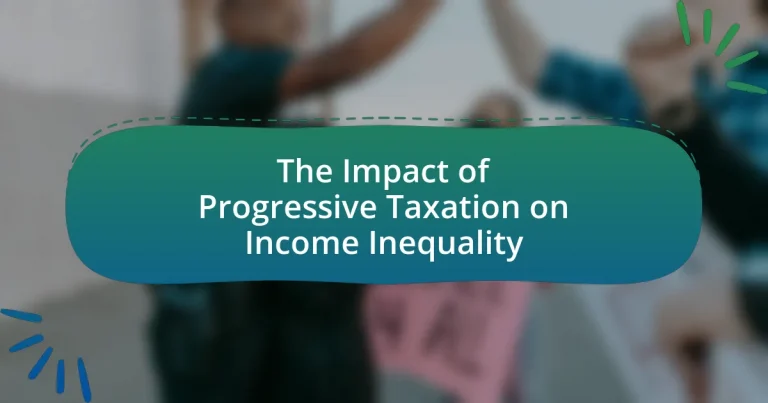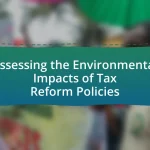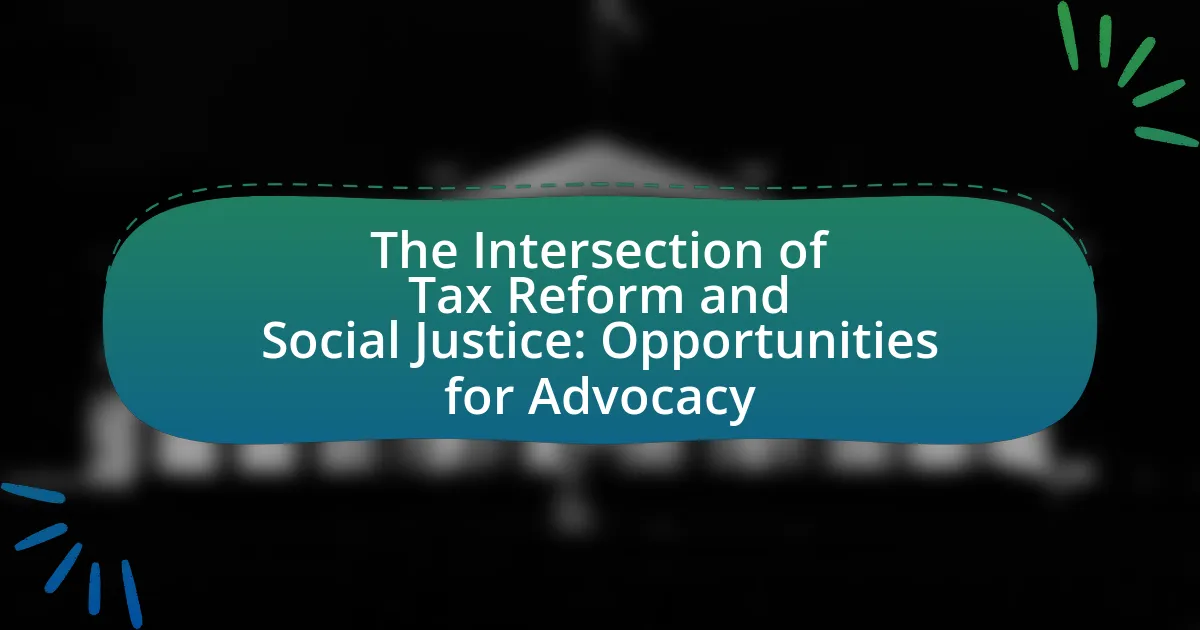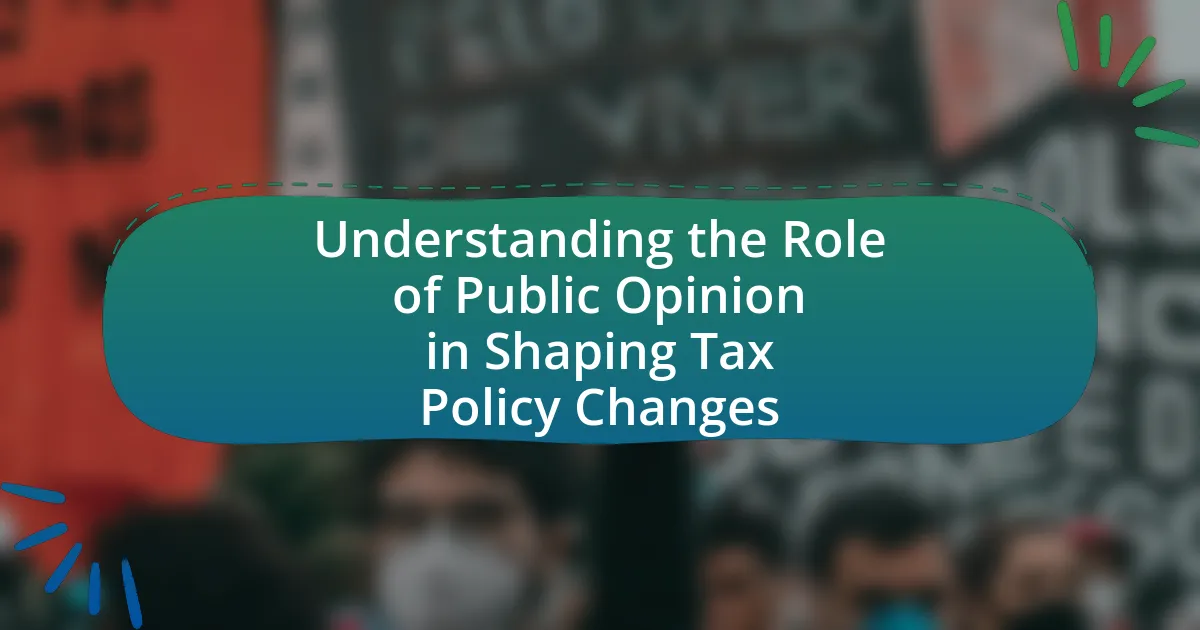The article examines the impact of progressive taxation on income inequality, highlighting how this tax system imposes higher rates on wealthier individuals to redistribute wealth and fund social programs. It contrasts progressive taxation with regressive and flat tax systems, emphasizing its effectiveness in reducing income disparities, as evidenced by data from the Organisation for Economic Co-operation and Development (OECD). Key features, theoretical foundations, and empirical evidence supporting progressive taxation are discussed, along with its influence on economic behavior and the challenges it faces. The article also explores future trends in taxation and the role of technology in shaping tax systems, providing practical steps for individuals to engage with and understand progressive taxation.
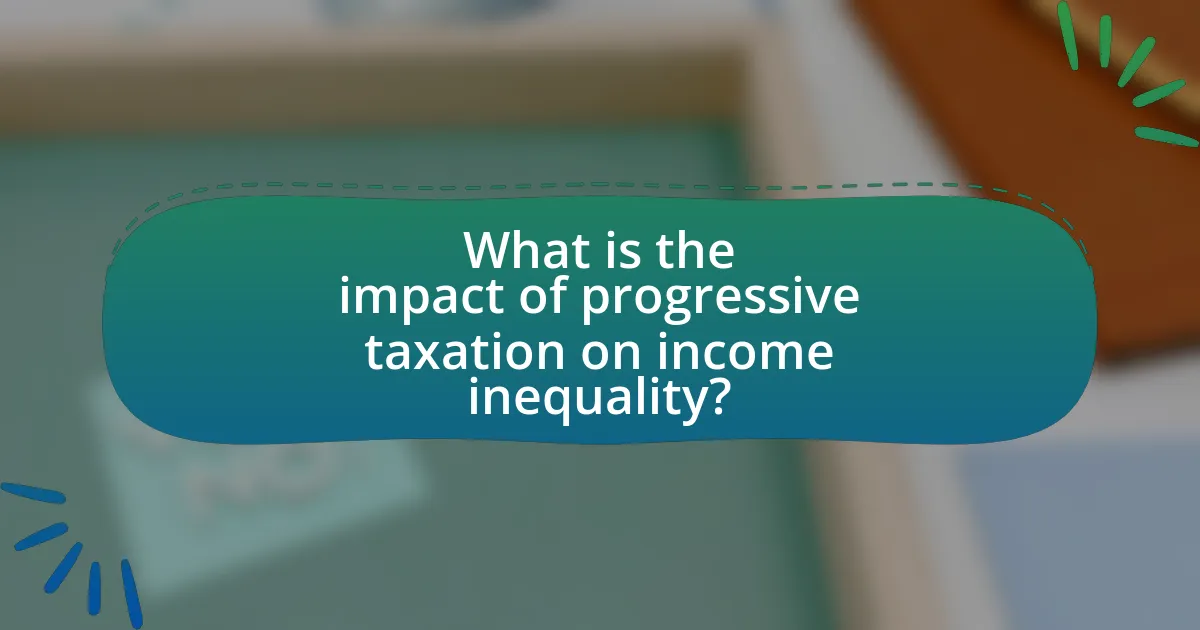
What is the impact of progressive taxation on income inequality?
Progressive taxation reduces income inequality by imposing higher tax rates on higher income brackets, thereby redistributing wealth. This system ensures that individuals with greater financial resources contribute a larger share of their income, which can then be used to fund social programs and services that benefit lower-income individuals. Research from the Organisation for Economic Co-operation and Development (OECD) indicates that countries with more progressive tax systems tend to have lower levels of income inequality, as evidenced by data showing that nations like Sweden and Denmark, which implement high progressive tax rates, also report some of the lowest Gini coefficients, a common measure of income inequality.
How does progressive taxation differ from other tax systems?
Progressive taxation differs from other tax systems by imposing higher tax rates on individuals with higher incomes, thereby increasing the tax burden as income rises. This system contrasts with regressive taxation, where lower-income individuals pay a higher percentage of their income in taxes, and flat taxation, where all individuals pay the same rate regardless of income level. For example, in the United States, the federal income tax system is progressive, with rates ranging from 10% to 37% based on income brackets, which aims to reduce income inequality by redistributing wealth.
What are the key features of progressive taxation?
Progressive taxation is characterized by tax rates that increase as an individual’s income rises. This system ensures that higher earners pay a larger percentage of their income in taxes compared to lower earners, effectively redistributing wealth. For example, in the United States, federal income tax rates range from 10% to 37%, with higher rates applied to higher income brackets. This structure aims to reduce income inequality by alleviating the tax burden on lower-income individuals while generating revenue from those who can afford to contribute more. Studies have shown that progressive taxation can lead to a decrease in income disparity, as evidenced by data from the OECD indicating that countries with more progressive tax systems tend to have lower levels of income inequality.
Why is progressive taxation considered beneficial for income distribution?
Progressive taxation is considered beneficial for income distribution because it imposes higher tax rates on individuals with higher incomes, thereby reducing income inequality. This system ensures that wealthier individuals contribute a larger share of their income to fund public services and social programs, which can help support lower-income populations. For instance, according to the Organisation for Economic Co-operation and Development (OECD), countries with progressive tax systems tend to have lower levels of income inequality compared to those with flat tax rates. This correlation highlights how progressive taxation can effectively redistribute wealth and provide essential services that benefit society as a whole.
What are the theoretical foundations of progressive taxation?
The theoretical foundations of progressive taxation are rooted in the principles of equity and social justice, which advocate for a tax system where individuals with higher incomes pay a larger percentage of their income in taxes compared to those with lower incomes. This concept is supported by the ability-to-pay principle, which posits that tax burdens should be distributed according to individuals’ financial capacity, thereby reducing income inequality. Empirical studies, such as those conducted by the Organisation for Economic Co-operation and Development (OECD), demonstrate that progressive tax systems can effectively lower income disparities and promote social welfare by redistributing wealth.
How do economic theories support progressive taxation?
Economic theories support progressive taxation by emphasizing the principle of ability to pay, which posits that individuals with higher incomes should contribute a larger percentage of their earnings to fund public goods and services. This principle is rooted in the concept of diminishing marginal utility, suggesting that as income increases, the additional satisfaction derived from each extra dollar decreases, making it more equitable for wealthier individuals to bear a higher tax burden. Empirical evidence, such as studies from the OECD, indicates that progressive taxation can reduce income inequality and promote social welfare by redistributing wealth and funding essential services like education and healthcare, which benefit society as a whole.
What role does social justice play in the argument for progressive taxation?
Social justice is a fundamental principle in the argument for progressive taxation, as it advocates for a fair distribution of wealth and resources within society. Progressive taxation, which imposes higher tax rates on individuals with greater income, aims to reduce income inequality by redistributing wealth to support public services and social programs that benefit lower-income populations. Research indicates that countries with progressive tax systems, such as Sweden and Denmark, experience lower levels of income inequality and enhanced social welfare, demonstrating the effectiveness of this approach in promoting social equity.
What evidence exists regarding the impact of progressive taxation on income inequality?
Progressive taxation reduces income inequality by imposing higher tax rates on higher income brackets, which redistributes wealth more equitably. Research conducted by the Organisation for Economic Co-operation and Development (OECD) indicates that countries with more progressive tax systems, such as Sweden and Denmark, exhibit lower levels of income inequality compared to those with flat tax systems, like Estonia. The OECD’s report from 2021 shows that progressive taxation can decrease the Gini coefficient, a common measure of income inequality, by up to 10% in some nations. This evidence supports the conclusion that progressive taxation effectively mitigates income inequality through wealth redistribution.
How have different countries implemented progressive taxation?
Different countries have implemented progressive taxation by establishing tax brackets where higher income levels are taxed at increased rates. For example, in the United States, the federal income tax system features multiple brackets, with rates ranging from 10% to 37% based on income levels, effectively redistributing wealth and addressing income inequality. Similarly, in Sweden, the tax system includes both national and municipal taxes, with top earners facing rates exceeding 60%, which funds extensive social welfare programs aimed at reducing inequality. In Germany, the progressive tax system has rates from 0% to 45%, with additional solidarity surcharges for higher earners, reinforcing the commitment to social equity. These implementations demonstrate how various nations utilize progressive taxation to mitigate income disparities and promote social welfare.
What statistical data supports the effectiveness of progressive taxation in reducing income inequality?
Progressive taxation effectively reduces income inequality, as evidenced by data from various studies. For instance, the OECD reports that countries with higher progressive tax rates, such as Sweden and Denmark, exhibit significantly lower Gini coefficients, which measure income inequality. Specifically, Sweden’s Gini coefficient is approximately 0.27, compared to the United States’ 0.41, highlighting the impact of progressive tax structures. Additionally, a study by the International Monetary Fund found that a 1% increase in the top marginal tax rate can reduce income inequality by 0.1 to 0.3 Gini points. These statistics demonstrate a clear correlation between progressive taxation and reduced income inequality.
How does progressive taxation influence economic behavior?
Progressive taxation influences economic behavior by altering individuals’ incentives to earn, save, and invest. Higher tax rates on increased income can discourage additional earnings, as individuals may perceive diminishing returns on their labor. For instance, research by the National Bureau of Economic Research indicates that higher marginal tax rates can lead to reduced labor supply among high-income earners, as they may choose to work less or engage in tax avoidance strategies. Additionally, progressive taxation can affect consumption patterns; lower-income individuals, who face lower tax rates, tend to spend a higher proportion of their income, stimulating demand in the economy. Conversely, higher taxes on wealthier individuals may lead to increased savings or investment in tax-advantaged accounts, impacting overall economic growth.
What effects does progressive taxation have on high-income earners?
Progressive taxation increases the tax burden on high-income earners, leading to a reduction in their disposable income. This system is designed to ensure that those with greater financial resources contribute a larger percentage of their income to fund public services and social programs. For instance, in the United States, the top marginal tax rate for high-income earners can exceed 37%, compared to lower rates for middle and low-income brackets. This structure aims to address income inequality by redistributing wealth, which can result in high-income earners feeling a financial pinch, potentially influencing their spending and investment behaviors. Studies have shown that progressive taxation can reduce income inequality, as evidenced by data from the OECD, which indicates that countries with more progressive tax systems tend to have lower levels of income disparity.
How does progressive taxation impact low and middle-income earners?
Progressive taxation benefits low and middle-income earners by reducing their tax burden relative to higher-income individuals. This system imposes higher tax rates on higher income brackets, allowing for lower rates on those with less income, which can lead to increased disposable income for low and middle-income households. For instance, according to the Tax Policy Center, in 2021, the bottom 20% of earners paid an average effective tax rate of about 1.5%, while the top 20% faced an average rate of approximately 24%. This structure helps to alleviate poverty and promote economic mobility by redistributing wealth and funding essential public services that disproportionately benefit lower-income groups.
What challenges and criticisms exist regarding progressive taxation?
Progressive taxation faces several challenges and criticisms, primarily centered around economic efficiency and equity. Critics argue that higher tax rates on the wealthy can discourage investment and economic growth, as evidenced by studies indicating that increased taxation on high-income earners may lead to reduced capital formation. Additionally, opponents claim that progressive taxation can create disincentives for hard work and innovation, as individuals may feel less motivated to earn more if a significant portion of their income is taxed at higher rates. Furthermore, there are concerns about the complexity of tax codes, which can lead to loopholes and inequities in tax burdens, undermining the intended fairness of the system. These criticisms highlight the ongoing debate about the balance between equity and efficiency in tax policy.
What are the common arguments against progressive taxation?
Common arguments against progressive taxation include claims that it disincentivizes hard work and innovation, as higher tax rates on increased income may discourage individuals from pursuing higher earnings. Critics argue that progressive taxation can lead to capital flight, where wealthy individuals move their assets or residency to lower-tax jurisdictions, ultimately reducing the tax base. Additionally, opponents contend that it can create a dependency on government assistance, undermining personal responsibility and initiative. They also assert that progressive tax systems can be complex and costly to administer, leading to inefficiencies and potential loopholes that can be exploited. These arguments are often supported by economic theories suggesting that lower tax rates can stimulate economic growth and investment.
How do critics argue that progressive taxation affects economic growth?
Critics argue that progressive taxation negatively affects economic growth by disincentivizing investment and entrepreneurship. They claim that higher tax rates on higher income brackets reduce the motivation for individuals and businesses to invest in new ventures, as the potential returns diminish due to increased taxation. For instance, a study by the National Bureau of Economic Research found that higher marginal tax rates can lead to lower levels of savings and investment, which are crucial for economic expansion. Additionally, critics assert that progressive taxation can result in capital flight, where wealthy individuals relocate to lower-tax jurisdictions, further stifling domestic economic growth.
How can policymakers effectively implement progressive taxation?
Policymakers can effectively implement progressive taxation by establishing tax brackets that increase rates for higher income levels, thereby ensuring that wealthier individuals contribute a larger percentage of their income. This approach has been validated by historical examples, such as the United States during the mid-20th century, where top marginal tax rates exceeded 90%, significantly reducing income inequality and funding social programs. Additionally, policymakers should regularly adjust tax brackets for inflation to maintain the effectiveness of the system over time, as demonstrated by the progressive tax reforms in Scandinavian countries, which have successfully reduced income disparities while promoting economic growth.
What best practices should be considered in designing a progressive tax system?
A progressive tax system should prioritize equity, simplicity, and efficiency. Equity ensures that individuals with higher incomes pay a larger percentage of their income in taxes, which can reduce income inequality; for instance, countries like Sweden and Denmark have implemented progressive tax rates that significantly contribute to lower income disparity. Simplicity in the tax code enhances compliance and reduces administrative costs; the U.S. tax system, for example, has faced criticism for its complexity, which can lead to tax evasion and avoidance. Efficiency involves minimizing economic distortions; research indicates that well-designed progressive taxes can maintain incentives for work and investment while still achieving revenue goals. These best practices collectively support the effectiveness of a progressive tax system in addressing income inequality.
How can governments address potential drawbacks of progressive taxation?
Governments can address potential drawbacks of progressive taxation by implementing measures that enhance tax compliance and minimize economic disincentives. For instance, simplifying the tax code can reduce administrative burdens and improve compliance rates, as evidenced by the Taxpayer Advocate Service’s report indicating that complexity in tax laws leads to higher rates of non-compliance. Additionally, governments can provide targeted tax credits or deductions to alleviate the financial burden on middle and lower-income earners, which can mitigate the negative impact on work incentives. Research from the Institute on Taxation and Economic Policy shows that well-designed tax credits can effectively support low-income households without discouraging employment. By focusing on these strategies, governments can maintain the equity goals of progressive taxation while minimizing its drawbacks.
What are the future trends in progressive taxation and income inequality?
Future trends in progressive taxation indicate a potential increase in tax rates for higher income brackets, aimed at reducing income inequality. This shift is driven by growing public support for wealth redistribution, as evidenced by surveys showing that a majority of citizens in various countries favor higher taxes on the wealthy to fund social programs. Additionally, governments are increasingly recognizing the need to address disparities exacerbated by economic crises, such as the COVID-19 pandemic, which highlighted the vulnerabilities of lower-income populations. Research from the International Monetary Fund suggests that progressive taxation can effectively reduce income inequality, as countries with higher tax rates on the wealthy tend to exhibit lower levels of income disparity.
How might global economic changes affect progressive taxation policies?
Global economic changes can lead to shifts in progressive taxation policies by influencing government revenue needs and public sentiment regarding wealth distribution. For instance, during economic downturns, governments may increase progressive tax rates to bolster revenue and address rising income inequality, as seen in the aftermath of the 2008 financial crisis when many countries adjusted tax policies to fund social programs. Conversely, in periods of economic growth, there may be pressure to lower tax rates to stimulate investment and consumption, potentially undermining progressive taxation. Historical data indicates that countries with robust progressive tax systems, like Sweden, have maintained these policies during economic expansions to ensure equitable wealth distribution, demonstrating that global economic conditions directly impact the structure and effectiveness of progressive taxation.
What role will technology play in shaping future taxation systems?
Technology will play a transformative role in shaping future taxation systems by enhancing efficiency, accuracy, and compliance. Advanced data analytics and artificial intelligence will enable tax authorities to process vast amounts of financial data in real-time, improving the detection of tax evasion and ensuring fairer tax assessments. For instance, the implementation of blockchain technology can provide transparent and immutable records of transactions, reducing fraud and increasing taxpayer trust. Additionally, digital platforms can facilitate easier tax filing and payment processes, leading to higher compliance rates among individuals and businesses. These technological advancements are supported by studies indicating that automation in tax administration can reduce operational costs by up to 30%, thereby allowing governments to allocate resources more effectively in addressing income inequality through progressive taxation.
What practical steps can individuals take to understand and engage with progressive taxation?
Individuals can take several practical steps to understand and engage with progressive taxation. First, they should educate themselves about the principles of progressive taxation, which is designed to tax higher incomes at higher rates, thereby reducing income inequality. Reading reputable sources such as government publications, economic studies, and articles from established financial institutions can provide a solid foundation.
Next, individuals can participate in community discussions or forums that focus on tax policy, allowing them to hear diverse perspectives and ask questions. Engaging with local advocacy groups that promote fair tax policies can also enhance understanding and provide avenues for involvement.
Additionally, individuals can analyze their own tax situations using online calculators or consulting with tax professionals to see how progressive taxation affects their finances. This personal analysis can clarify the impact of tax brackets and deductions on their overall tax burden.
Finally, staying informed about legislative changes and participating in public comment periods or town hall meetings can empower individuals to voice their opinions on tax policies, ensuring their engagement in the democratic process surrounding taxation.
